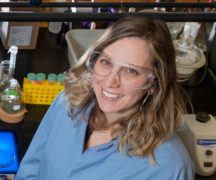By DAVID DUPONT
BG Independent News
Dr. Alexis Ostrowski served up some spaghetti and meatballs at Bowling Green State University’s first Science Café.
Not literally, of course. The professor of chemistry used the pasta dish as the image for the compound made of iron and alginate that’s at the heart of her research, and now at the center of a concept of how to address toxic algal blooms in Lake Erie.
The first Science Café was held Saturday. Dr. Tim Davis, a professor of biological sciences, explained that the monthly events are aimed at sharing faculty research related to Lake Erie with the broader community. “We really wanted to connect on a more person-to-person level.”
As conceived the cafés would have been held in informal community spaces such as coffee shops and breweries, but that’s not possible. So, Saturday’s café was held inside the ballroom at the Bowen-Thompson Student Union where about 20 people could be seated socially distanced, while another few dozen watched remotely.
Ostrowski traced how a basic research question led to addressing a critical environmental problem.
Ostrowski, who came to BGSU in 2012, is affiliated with the Center for Photochemical Research. She has received a National Science Foundation CAREER award. That marks her as “an up-and-coming researcher,” Davis said.
The interaction of light with iron in its FE(III) state produces fascinating results, one that’s been used by artists as well as scientists. It is one of the oldest chemical reactions.
A paper by Dr. Carl Carrano of San Diego State looked at how FE(III) is involved in biological systems, particularly sea kelp.
With this research in mind, Ostrowski and then doctoral student Giuseppe Giammanco were inspired by seeing brown seaweed spread across a beach. They wondered, Ostrowski said, whether this photochemical reaction was occurring in seaweed.
They decided to model the process in a compound using iron and polysaccharide (alginate). The result was the spaghetti and meatball-like structure. The alginate formed the long strands like the pasta while the iron formed as clusters within like meatballs.
This formed a jam-like consistency, a hydrogel.
When light was shined onto this hydrogel, it changed the interactions of the strands and clusters. The spaghetti, as it were, was cut up, the meatballs started breaking down. It became a liquid.
The research team had developed biodegradable beads.
As a scientist Ostrowski wondered: “What can we use this for?”
At about this time her and the rest of the region’s attention was rivetted by the 2014 water crisis in Toledo that left about 500,000 people without water. The problem was algae created a highly toxic microcystin bloom over the Toledo water system’s intake valve.
One of her colleagues Dr. Bob Midden was working on a solution to what was widely believed to be a major source of the problem – runoff from farm fields in the Maumee River Watershed.
He was looking at ways to trap the phosphate that was a main culprit in promoting the toxic algal blooms.
“What I love about Dr. Midden’s work is he’s not just looking at this as a waste problem, but as a way to create a really great resource for the farmer,” Ostrowski said.
These large-scale dairy operations are trying to manage the problem. The liquid waste is stored in lagoons. This can be sprayed on fields, but that’s expensive, she said. And if it rains the next day, the nutrients just run off into the watershed.
Also, heavy rains, which are becoming more common because of climate change, can cause the lagoons to overflow and release the liquid manure and its nutrients into the system.
Midden is looking at a way of mining the phosphate in solid form. That makes it possible to recycle it as fertilizer. This becomes important as the sources for natural phosphates are diminishing.
Chemistry has shown that those “spaghetti-and-meatballs” compounds can trap the phosphates, Ostrowski said.
Those beads with the trapped phosphate can then be applied to the field where they will break down in the light.
The vision, she said is to “create a recycling method to take the animal waste from the dairy cows, suck up the phosphate in these hydrogel beads, and then use that as fertilizer for plants those plants eaten by animals or humans.”
Another doctoral student Jayan Karunarathna looked at the effect these beads had on tomato plants grown in the BGSU greenhouses. The plants fertilized with these beads didn’t do quite as well as those treated with commercial fertilizer, but much better than those not fertilized, Ostrowski reported. And the beads did not damage the plants.
The next step would be to test it on a farm field, she said.
At this point, the beads are too expensive to produce to be economically feasible.
The work is continuing.
Ostrowski urged those in the audience to get involved. Students are eligible for paid positions working in the university’s labs. And the public can become citizen scientists, helping to monitor the region’s waterways.
The Rotarians in District 6600 have doing testing in the watershed for the past several years, she said.



